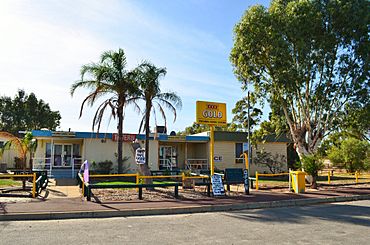Eneabba, Western Australia facts for kids
Quick facts for kids EneabbaWestern Australia |
|
|---|---|

Eneabba Sands Tavern, 2014.
|
|
| Established | 1961 |
| Postcode(s) | 6518 |
| Elevation | 99 m (325 ft) |
| Area | [convert: needs a number] |
| Location | |
| LGA(s) | Shire of Carnamah |
| State electorate(s) | Moore |
| Federal Division(s) | Durack |
Eneabba is a town on the Brand Highway 278 kilometres (173 mi) north of Perth, Western Australia.
The area is famous for its spectacular display of wildflowers in the spring. It is also home to the Iluka Resources mineral sands facility.
The first European visit to the area was in 1839 by the second disastrous George Grey expedition along the west coast. Grey and his party were forced to walk through the area after their boats were lost. On 11 April, Grey discovered and named the Arrowsmith River, after John Arrowsmith the English cartographer.
The next Europeans in the area were government Assistant Surveyor Augustus Charles Gregory and Francis Thomas Gregory (both attached to the department of the Surveyor-General) and their brother Henry Churchman Gregory, on a public-private funded expedition to search for new agricultural land beyond the settled areas. They camped at Eneabba Springs, 14 km (9 mi) east of Eneabba on 14 September 1846, while returning to Perth from the Irwin River.
In 1870 the first settler, William Horsley Rowland, arrived from Greenough. He took up a 1,200 ha (3,000 acres) lease at Eneabba Springs and survived by shepherding, trapping horses and pigs and living on wild game.
The area around Eneabba (also known as the Eneabba sandplain) was opened up for agricultural purposes in the 1950s for a large group of model farms comprising the Eneabba War Service Land Settlement Project. This in turn initiated the need for a town to be developed. The town was gazetted on 27 January 1961.
The name of the town means "ground spring", from the aboriginal name of Eneabba Springs, the site of Rowland's original homestead.
In April 1976, the Dongara–Eneabba railway line opened, linking the Iluka Resources mineral sands mine at Eneabba to the Midland railway line at Dongara.
The Warradarge Wind Farm is being constructed southeast of Eneabba.
Climate
Eneabba has a Mediterranean climate#Hot-summer mediterranean climate (Köppen Csa).
| Climate data for Eneabba (1981–2010 normals; extremes 1972–2017) | |||||||||||||
|---|---|---|---|---|---|---|---|---|---|---|---|---|---|
| Month | Jan | Feb | Mar | Apr | May | Jun | Jul | Aug | Sep | Oct | Nov | Dec | Year |
| Record high °C (°F) | 47.3 (117.1) |
48.7 (119.7) |
44.9 (112.8) |
40.0 (104.0) |
36.1 (97.0) |
29.0 (84.2) |
29.3 (84.7) |
30.5 (86.9) |
35.4 (95.7) |
41.0 (105.8) |
45.2 (113.4) |
45.9 (114.6) |
48.7 (119.7) |
| Mean daily maximum °C (°F) | 36.3 (97.3) |
36.3 (97.3) |
33.6 (92.5) |
29.6 (85.3) |
24.5 (76.1) |
20.9 (69.6) |
19.6 (67.3) |
20.7 (69.3) |
23.2 (73.8) |
26.8 (80.2) |
30.3 (86.5) |
33.3 (91.9) |
27.9 (82.2) |
| Mean daily minimum °C (°F) | 18.6 (65.5) |
19.4 (66.9) |
18.1 (64.6) |
15.4 (59.7) |
12.4 (54.3) |
10.2 (50.4) |
8.9 (48.0) |
9.0 (48.2) |
9.8 (49.6) |
11.4 (52.5) |
14.0 (57.2) |
16.1 (61.0) |
13.6 (56.5) |
| Record low °C (°F) | 9.2 (48.6) |
8.8 (47.8) |
9.7 (49.5) |
7.6 (45.7) |
4.2 (39.6) |
1.7 (35.1) |
0.5 (32.9) |
2.3 (36.1) |
2.9 (37.2) |
3.4 (38.1) |
5.9 (42.6) |
7.5 (45.5) |
0.5 (32.9) |
| Average precipitation mm (inches) | 8.3 (0.33) |
15.3 (0.60) |
15.5 (0.61) |
22.4 (0.88) |
71.6 (2.82) |
88.0 (3.46) |
93.3 (3.67) |
75.4 (2.97) |
46.8 (1.84) |
22.8 (0.90) |
15.5 (0.61) |
10.4 (0.41) |
486.3 (19.15) |
| Average precipitation days | 1.5 | 2.1 | 2.9 | 5.1 | 10.2 | 12.8 | 14.7 | 13.4 | 10.7 | 6.4 | 4.2 | 2.4 | 86.4 |
| Average afternoon relative humidity (%) | 31 | 30 | 34 | 40 | 47 | 55 | 57 | 54 | 49 | 42 | 38 | 33 | 43 |
| Source: Bureau of Meteorology | |||||||||||||


